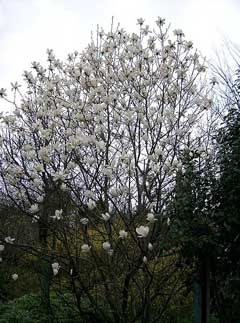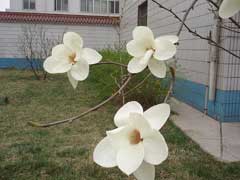 |
|
http://commons.wikimedia.org/wiki/User:KENPEI |
 |
| http://commons.wikimedia.org/wiki/User:Fanghong |
Translate this page:
Summary
Bloom Color: White. Main Bloom Time: Early spring, Late spring, Mid spring. Form: Rounded, Spreading or horizontal.
Physical Characteristics

 Magnolia denudata is a deciduous Tree growing to 10 m (32ft) by 10 m (32ft) at a slow rate.
Magnolia denudata is a deciduous Tree growing to 10 m (32ft) by 10 m (32ft) at a slow rate.
See above for USDA hardiness. It is hardy to UK zone 6 and is not frost tender. It is in flower from March to May, and the seeds ripen from September to November. The species is hermaphrodite (has both male and female organs) and is pollinated by Beetles.
Suitable for: light (sandy), medium (loamy) and heavy (clay) soils and prefers well-drained soil. Suitable pH: mildly acid and neutral soils. It can grow in semi-shade (light woodland) or no shade. It prefers moist soil. It can tolerate atmospheric pollution.
UK Hardiness Map
US Hardiness Map
Synonyms
M. conspicua. Salisb. M. heptapeta. (Buch-Hoz.)Dandy.
Plant Habitats
Woodland Garden Canopy; Secondary;
Edible Uses
Edible Parts:
Edible Uses: Condiment
The flowers, after the calyx has been removed, are pickled and used for flavouring rice[183].
References More on Edible Uses
Medicinal Uses
Plants For A Future can not take any responsibility for any adverse effects from the use of plants. Always seek advice from a professional before using a plant medicinally.
Anodyne Antifungal Astringent Carminative Cytotoxic Diaphoretic Hypotensive Sedative
Tonic Uterine tonic
Tonic[177]. The flower buds and the seeds are carminative and diaphoretic[218]. The flower buds are antifungal, astringent, cytotoxic, hypotensive and a uterie stimulant[279]. They are used in Korea in the treatment of headaches, nasal obstruction and sinusitis[279]. They are picked in early spring, dried and then used in Chinese medicine to clear the nasal passages[177]. The plant is anodyne and sedative[218].
References More on Medicinal Uses
The Bookshop: Edible Plant Books
Our Latest books on Perennial Plants For Food Forests and Permaculture Gardens in paperback or digital formats.

Edible Tropical Plants
Food Forest Plants for Hotter Conditions: 250+ Plants For Tropical Food Forests & Permaculture Gardens.
More

Edible Temperate Plants
Plants for Your Food Forest: 500 Plants for Temperate Food Forests & Permaculture Gardens.
More

More Books
PFAF have eight books available in paperback and digital formats. Browse the shop for more information.
Shop Now
Other Uses
References More on Other Uses
Cultivation details
Landscape Uses:Border, Espalier, Firewood, Pest tolerant, Specimen. Best grown in a warm position in a moderately rich free soil of an open texture[1]. Succeeds in an acid or neutral peaty soil in sun or part shade[184]. Tolerates alkaline soils so long as they are deep and rich in humus[188]. The branches are brittle so a sheltered position is required[200]. Very tolerant of atmospheric pollution[200]. A very ornamental tree[1], it is hardy to about -20°c when dormant[184] but plants can be excited into early growth by mild winters and the flowers are then liable to be killed by frost[11]. The flowers, which begin to be produced when the plant is quite young, are deliciously scented[245]. The fleshy roots are easily damaged and any transplanting is best done during a spell of mild moist weather in late spring[182]. Special Features:
Not North American native, Fragrant flowers, Blooms are very showy.
References Carbon Farming Information and Carbon Sequestration Information
Temperature Converter
Type a value in the Celsius field to convert the value to Fahrenheit:
Fahrenheit:
The PFAF Bookshop
Plants For A Future have a number of books available in paperback and digital form. Book titles include Edible Plants, Edible Perennials, Edible Trees,Edible Shrubs, Woodland Gardening, and Temperate Food Forest Plants. Our new book is Food Forest Plants For Hotter Conditions (Tropical and Sub-Tropical).
Shop Now
Plant Propagation
Seed - best sown as soon as it is ripe in a cold frame. Stored seed must be kept cold over the winter and should be sown in late winter in a cold frame[200]. The seed usually germinates in the spring but it can take 18 months. Prick out the seedlings into individual pots when they are large enough to handle and grow them on in light shade in a cold frame or greenhouse for at least their first winter. They can be planted out into their permanent positions when they are more than 15cm tall, though should be well mulched and given some protection from winter cold for their first winter or two outdoors. Layering in early spring[200].
Other Names
If available other names are mentioned here
Native Plant Search
Search over 900 plants ideal for food forests and permaculture gardens. Filter to search native plants to your area. The plants selected are the plants in our book 'Plants For Your Food Forest: 500 Plants for Temperate Food Forests and Permaculture Gardens, as well as plants chosen for our forthcoming related books for Tropical/Hot Wet Climates and Mediterranean/Hot Dry Climates. Native Plant Search
Found In
Countries where the plant has been found are listed here if the information is available
Weed Potential
Right plant wrong place. We are currently updating this section.
Please note that a plant may be invasive in one area but may not in your area so it’s worth checking.
Conservation Status
IUCN Red List of Threatened Plants Status :

| Related Plants
|
| Latin Name | Common Name | Habit | Height | Hardiness | Growth | Soil | Shade | Moisture | Edible | Medicinal | Other |
| Liriodendron tulipifera | Tulip Tree, Tulip Poplar, Yellow Poplar, Canary Whitewood | Tree | 30.0 |
4-9
| M | LMH | N | M | 1 | 2 | 3 |
| Magnolia acuminata | Cucumber Tree, Cucumber Magnolia | Tree | 20.0 |
3-8
| M | LMH | SN | M | 0 | 3 | 2 |
| Magnolia campbellii | | Tree | 20.0 |
7-10
| | LMH | SN | M | 0 | 0 | 2 |
| Magnolia dodecapetala | Bwapen mawon | Tree | 35.0 |
10-12
| S | LMH | N | M | 0 | 0 | 4 |
| Magnolia grandiflora | Southern Magnolia, Bull Bay, Large-flowered Magnolia, Southern Magnolia | Tree | 10.0 |
6-10
| M | LMH | SN | M | 2 | 2 | 3 |
| Magnolia hypoleuca | Whitebark Magnolia | Tree | 15.0 |
5-9
| M | LMH | SN | M | 2 | 2 | 2 |
| Magnolia kobus | Kobus magnolia, Northern Japanese Magnolia | Tree | 12.0 |
4-7
| M | LMH | SN | M | 1 | 1 | 2 |
| Magnolia liliiflora | Mu-Lan, Woody Orchid, Lily Magnolia | Shrub | 3.0 |
4-9
| M | LMH | SN | M | 0 | 3 | |
| Magnolia macrophylla | Bigleaf Magnolia | Tree | 10.0 |
5-8
| S | LMH | SN | M | 0 | 1 | 2 |
| Magnolia officinalis | Hou Po | Tree | 20.0 |
7-10
| | LMH | SN | M | 0 | 3 | 2 |
| Magnolia stellata | Star Magnolia | Shrub | 5.0 |
4-8
| S | LMH | SN | M | 1 | 0 | |
| Magnolia virginiana | Laurel Magnolia, Sweetbay | Tree | 10.0 |
4-8
| S | LMH | SN | M | 1 | 3 | 2 |
| Michelia figo | Banana Shrub, Michelia | Shrub | 5.0 |
8-10
| M | LMH | SN | M | 1 | 0 | |
| Schisandra chinensis | Magnolia Vine, Wu Wei Zi | Climber | 9.0 |
4-8
| M | LMH | FS | M | 4 | 5 | 2 |
|
Growth: S = slow M = medium F = fast. Soil: L = light (sandy) M = medium H = heavy (clay). pH: A = acid N = neutral B = basic (alkaline). Shade: F = full shade S = semi-shade N = no shade. Moisture: D = dry M = Moist We = wet Wa = water.

Expert comment
Author
Desr.
Botanical References
11109200
Links / References
For a list of references used on this page please go here
Readers comment
| Add a comment |
|
If you have important information about this plant that may help other users please add a comment or link below. Only comments or links that are felt to be directly relevant to a plant will be included. If you think a comment/link or information contained on this page is inaccurate or misleading we would welcome your feedback at [email protected]. If you have questions about a plant please use the Forum on this website as we do not have the resources to answer questions ourselves.
* Please note: the comments by website users are not necessarily those held by PFAF and may give misleading or inaccurate information.
To leave a comment please Register or login here All comments need to be approved so will not appear immediately.
|
Subject : Magnolia denudata
|
|
|
|